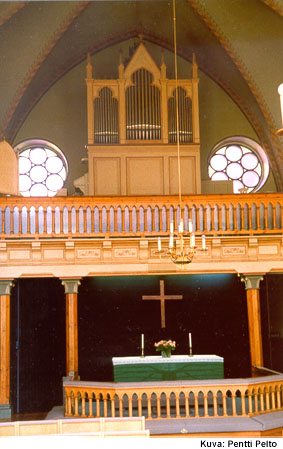|
HISTORICAL ORGANS IN FINLAND 
Helsinki Deaconess Institute- Thulé, Bror Axel 1902
- 8 stops, 2 manuals and pedal
- pneumatic action and pneumatic stop action
The Helsinki Deaconess Institute building, designed by architect K.A. Wrede and completed in 1898, incorporates a nave church with Medieval influences in its details.
Bror Axel Thulé built a two-manual organ in the loft above the altar in 1902. The organ was repaired and its disposition changed in 1957, but most of these changes were dismantled in 1993 in cooperation between Kriisa organ builders of Estonia and Helmuth Gripentrog. The organ is the oldest pneumatic organ in Helsinki preserved in its original location.
Appearance
The organ is located in the loft above the altar. The Manual I chest is immediately behind the façade, and the Manual II swell box is behind that. The Pedal division is furthest back. The large bellows is under the chests.
The three flats have cloverleaf tops. The steeply pitched pediment of the middle flat emphasizes the middle of the façade, since the flanking flats are oblong. The pillars of the façade continue into finials with diminutive terminal decorations. The mouths of the façade pipes form a straight line; some of the façade pipes are speaking pipes. The decorations are in the Neo-Gothic style. The panelled side walls of the organ case continue up to the church wall.
Technical features
The stop channel chests are pneumatic cone chests, which is rare in a Bror Axel Thulé organ. The only other preserved instrument to have such chests is the Suoniemi organ, completed in 1903.
The pneumatic console is set into the left wall of the organ. It has two manual keyboards with celluloid and ebony coverings, and above these a row of round stop switches. The action is pneumatic, with thin lead pipes conveying the organist’s movements as pressure changes.
The reservoir is a double rise reservoir, from which the wind passes through round wood channels to the stop chest. Concussion bellows even out pressure fluctuations.
Musical properties
The organ is typical of the time of its building, although it has not been restored to its original state. The sound is soft and singing, perhaps a bit strident in the violin stops. Manual I is powerful, while Manual II has softer and quieter tones.
Disposition
Manual I C-f3 | Manual II C-f3 | Pedal C-d1 |
Principal 8’ | Liebl.Gedackt 8’ | Subbass 16’ |
Borduna 8’ | Aeoline 8’ | |
Gamba 8’ | Flöjt 4’ | |
Octava 4’ | | |
Mixtur 3x | | |
| | |
| | |
| | |
| | |
| | |
| | |
| | |
| | |
|
|
|
II-I, I-Ped, II-Ped, I 4’, II-I 16’ | | |
The melody coupling was disconnected in 1957. | | |
| | |
| | |
| | |
| | |
| | |
| | |
| | |
| | |
| | |
| | |
| | |
Further information
Markus Malmgren, Diakonissalaitoksen urut, Organum 3/1993
|